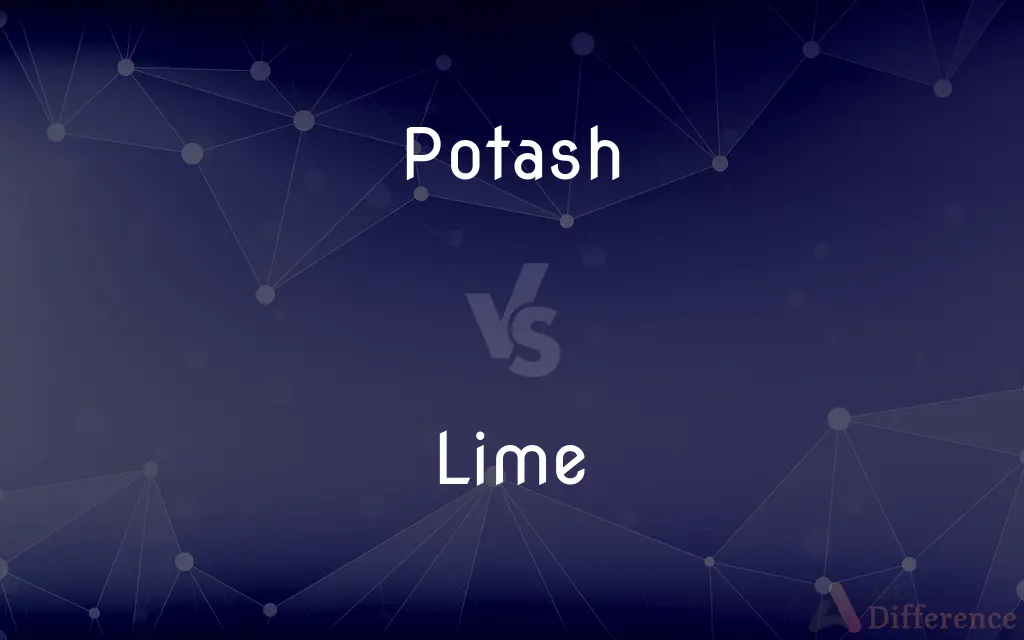Potash vs. Lime — What's the Difference?
By Urooj Arif & Maham Liaqat — Updated on March 28, 2024
Potash is a potassium-based fertilizer enhancing plant growth and health, while lime, primarily calcium carbonate, neutralizes acidic soil, improving nutrient availability.

Difference Between Potash and Lime
Table of Contents
ADVERTISEMENT
Key Differences
Potash, a term historically referring to potassium carbonates and potassium-bearing materials, is crucial for plant growth, aiding in water retention, disease resistance, and enzyme activation. Lime, on the other hand, primarily made of calcium carbonate, is used to increase soil pH, counteracting acidity and making essential nutrients more accessible to plants.
The primary use of potash in agriculture is as a fertilizer to supply potassium, one of the three primary nutrients alongside nitrogen and phosphorus. Whereas, lime is applied to soil to raise its pH level, helping to reduce toxicity from elements like aluminum and manganese, which can become more soluble and harmful in acidic conditions.
Potash directly contributes to several physiological processes in plants, including photosynthesis, nutrient movement, and starch synthesis. Lime's role, while indirectly beneficial to plant growth, revolves around soil condition improvement, enhancing nutrient uptake by altering the soil's chemical properties.
In terms of application, potash fertilizers, such as potassium chloride (KCl) or potassium sulfate (K2SO4), are added based on soil potassium levels and plant needs, often applied during the planting or growing seasons. Lime is applied less frequently, depending on soil test results, and may take months to alter the soil pH significantly.
Environmental considerations also differentiate the two; excessive use of potash can lead to nutrient leaching and water pollution, whereas lime application must be carefully managed to avoid raising soil pH too high, which can lead to nutrient lockout, where plants cannot absorb certain nutrients efficiently.
ADVERTISEMENT
Comparison Chart
Composition
Potassium carbonates and potassium-bearing materials.
Primarily calcium carbonate (CaCO3) or calcium magnesium carbonate (CaMg(CO3)2).
Primary Use
Fertilizer to supply potassium, enhancing growth and health.
Neutralizes acidic soil, improving nutrient availability.
Effect on Plants
Improves water retention, disease resistance, enzyme activities.
Increases soil pH, reducing toxicity from soluble elements.
Application Timing
Based on soil and plant needs, often during planting or growing seasons.
Less frequently, as needed based on soil tests; effects can take months.
Environmental Impact
Risk of nutrient leaching and water pollution if overused.
Potential for raising soil pH too high, leading to nutrient lockout.
Compare with Definitions
Potash
Historically, potassium carbonate produced from wood ash.
Potash was once made by leaching wood ashes and evaporating the solution in iron pots.
Lime
A soil amendment that raises pH and reduces acidity.
Lime was spread over the acidic fields to improve soil health.
Potash
Improves the quality and yield of agricultural crops.
Using potash significantly increased the yield and quality of the tomatoes.
Lime
Enhances nutrient availability and prevents toxicities.
Lime application has prevented aluminum toxicity in crops by neutralizing soil acidity.
Potash
A potassium-containing fertilizer used in agriculture.
The farmer applied potash to enhance the crop's growth and fruit quality.
Lime
Used in agriculture and gardening to improve soil structure.
Adding lime to the clay soil improved its structure and aeration.
Potash
Aids in the activation of various plant enzymes.
Potash is crucial for activating enzymes that regulate growth rates.
Lime
Made primarily from ground limestone (calcium carbonate).
The garden's lime is derived from natural limestone, rich in calcium.
Potash
Essential for plant water uptake and stress resistance.
Regular potash application helps plants endure drought conditions better.
Lime
Can be dolomitic or calcitic, depending on magnesium content.
Dolomitic lime was chosen for its magnesium content, beneficial for plant growth.
Potash
Potash () includes various mined and manufactured salts that contain potassium in water-soluble form. The name derives from pot ash, which refers to plant ashes or wood ash soaked in water in a pot, which was the primary means of manufacturing the product before the Industrial Era.
Lime
A bright light green colour like that of a lime
A lime-green bikini
Potash
An alkaline potassium compound, especially potassium carbonate or hydroxide.
Lime
A white caustic alkaline substance consisting of calcium oxide, which is obtained by heating limestone and which combines with water with the production of much heat; quicklime.
Potash
See potassium carbonate.
Lime
Birdlime.
Potash
See potassium hydroxide.
Lime
A rounded citrus fruit similar to a lemon but greener, smaller, and with a distinctive acid flavour
Wedges of lime
Lime juice
Roughly chop two limes
Potash
Any of several compounds containing potassium, especially soluble compounds such as potassium oxide, potassium chloride, and various potassium sulfates, used chiefly in fertilizers.
Lime
The evergreen citrus tree which produces limes, widely cultivated in warm climates.
Potash
The water-soluble part of the ash formed by burning plant material; used for making soap and glass and as a fertilizer.
Lime
A deciduous tree with heart-shaped leaves and fragrant yellowish blossom, native to north temperate regions. The pale timber is used for carving and inexpensive furniture.
Potash
(chemistry) An impure form of potassium carbonate (K2CO3) mixed with other potassium salts.
Lime
An informal social gathering characterized by semi-ritualized talking.
Potash
. Chiefly used in the names of compounds of the form "... of potash".
[[potassium permanganate
Lime
Treat (soil or water) with lime to reduce acidity and improve fertility or oxygen levels
They were liming acidified lakes
Potash
A class of potassium minerals, of similar applicability to potassium carbonate, such as being a fertilizer. (ie. potassium chloride, potassium hydroxide)
Lime
Catch (a bird) with birdlime
The bird that hath been limed in a bush
Potash
To treat with potassium.
Lime
Sit or stand around talking with others
Boys and girls were liming along the roadside as if they didn't have anything to do
Potash
The hydroxide of potassium hydrate, a hard white brittle substance, KOH, having strong caustic and alkaline properties; - hence called also caustic potash.
Lime
Any of several evergreen trees or shrubs of the genus Citrus having edible green or greenish-yellow fruit, especially the Mexican lime and the Persian lime.
Potash
A potassium compound often used in agriculture and industry
Lime
The fruit of any of these plants, having a pulpy interior and usually acid juice.
Lime
See linden.
Lime
See calcium oxide.
Lime
Any of various mineral and industrial forms of calcium oxide differing chiefly in water content and percentage of constituents such as magnesia, silica, alumina, and iron.
Lime
Birdlime.
Lime
To treat with lime.
Lime
To smear with birdlime.
Lime
To catch or snare with or as if with birdlime.
Lime
(chemistry) Any inorganic material containing calcium, usually calcium oxide (quicklime) or calcium hydroxide (slaked lime).
Lime
(poetic) Any gluey or adhesive substance; something which traps or captures someone; sometimes a synonym for birdlime.
Lime
(theatre) A spotlight.
Lime
A deciduous tree of the genus Tilia, especially Tilia × europaea; the linden tree.
Lime
The wood of this tree.
Lime
Any of several green citrus fruit, somewhat smaller and sharper-tasting than a lemon.
Lime
Any of the trees that bear limes, especially Key lime, Citrus aurantiifolia.
Lime
(uncountable) A brilliant, sometimes yellowish, green colour associated with the fruits of a lime tree.
Lime
(fandom) A fan fiction story which contains sexual references, but stops short of full, explicit descriptions of sexual activity (coined by analogy with lemon).
Lime
A casual gathering to socialize.
Lime
(transitive) To treat with calcium hydroxide or calcium oxide (lime).
Lime
(transitive) To smear with birdlime.
Lime
(rare) To ensnare, catch, entrap.
Lime
(transitive) To apply limewash.
Lime
To hang out/socialize in an informal, relaxed environment, especially with friends, for example at a party or on the beach.
Lime
Containing lime or lime juice.
Lime
Having the aroma or flavor of lime.
Lime
Lime-green.
Lime
A thong by which a dog is led; a leash.
Lime
The linden tree. See Linden.
Lime
The fruit of the Citrus aurantifolia, allied to the lemon, but greener in color; also, the tree which bears it.
Lime
The color of the lime{1}, a yellowish-green.
Lime
Birdlime.
Like the limeThat foolish birds are caught with.
Lime
Oxide of calcium, CaO; the white or gray, caustic substance, usually called quicklime, obtained by calcining limestone or shells, the heat driving off carbon dioxide and leaving lime. It develops great heat when treated with water, forming slaked lime, and is an essential ingredient of cement, plastering, mortar, etc.
Lime
To smear with a viscous substance, as birdlime.
These twigs, in time, will come to be limed.
Lime
To entangle; to insnare.
We had limed ourselvesWith open eyes, and we must take the chance.
Lime
To treat with lime, or oxide or hydrate of calcium; to manure with lime; as, to lime hides for removing the hair; to lime sails in order to whiten them; to lime the lawn to decrease acidity of the soil.
Land may be improved by draining, marling, and liming.
Lime
To cement.
Lime
Having a yellowish-green color like that of the lime (the fruit).
Lime
A caustic substance produced by heating limestone
Lime
A white crystalline oxide used in the production of calcium hydroxide
Lime
A sticky adhesive that is smeared on small branches to capture small birds
Lime
Any of various related trees bearing limes
Lime
Any of various deciduous trees of the genus Tilia with heart-shaped leaves and drooping cymose clusters of yellowish often fragrant flowers; several yield valuable timber
Lime
The green acidic fruit of any of various lime trees
Lime
Spread birdlime on branches to catch birds
Lime
Cover with lime so as to induce growth;
Lime the lawn
Common Curiosities
Can potash and lime be used together?
Yes, potash and lime can be used together if soil tests indicate a need for both potassium supplementation and pH adjustment.
Why is lime added to soil?
Lime is added to soil to increase its pH level, neutralizing acidity, and making essential nutrients more accessible to plants.
How often should potash and lime be applied?
Potash application depends on plant and soil needs, often seasonally, while lime is applied less frequently, based on soil test results and may take months to affect soil pH.
Can lime help prevent plant diseases?
While lime primarily affects soil pH, it can indirectly help prevent some soil-borne diseases by creating less favorable conditions for their development.
How do potash and lime affect plant growth?
Potash directly contributes to improved plant health and growth by enhancing water retention and disease resistance, while lime indirectly benefits plants by improving soil conditions and nutrient availability.
What crops benefit most from potash?
Crops that benefit most from potash include those with high potassium requirements, such as potatoes, tomatoes, and leafy greens.
What is potash used for?
Potash is used as a fertilizer to supply potassium, essential for plant growth, health, and development.
What are the environmental concerns associated with potash and lime?
Excessive use of potash can lead to nutrient leaching and water pollution, whereas improper lime application can raise soil pH too much, causing nutrient lockout.
Are there different types of lime?
Yes, lime can be calcitic or dolomitic, with the main difference being dolomitic lime also contains magnesium, beneficial for plants needing this nutrient.
Can potash toxicity occur in plants?
Yes, excessive potash can lead to toxicity symptoms in plants, such as leaf burn or scorch.
What is the best time of year to apply potash and lime?
The best time to apply potash is during the planting or growing seasons based on crop needs, while lime can be applied in fall or spring, allowing time for pH adjustment before major plant growth periods.
What role does lime play in organic gardening?
In organic gardening, lime is used to correct soil acidity, enhancing nutrient availability naturally without synthetic chemicals.
How does soil pH affect potash and lime application?
Soil pH directly influences the need for lime (in acidic soils) and can affect how plants utilize potassium, potentially altering potash application rates.
How does potash affect water quality?
If not managed properly, potash can leach into waterways, contributing to nutrient pollution and potentially harming aquatic ecosystems.
Is lime safe for all plants?
Most plants benefit from lime if applied correctly, but some acid-loving plants, like blueberries and azaleas, may suffer in less acidic conditions.
Share Your Discovery

Previous Comparison
Osteopetrosis vs. Osteoporosis
Next Comparison
Commerce vs. FinanceAuthor Spotlight
Written by
Urooj ArifUrooj is a skilled content writer at Ask Difference, known for her exceptional ability to simplify complex topics into engaging and informative content. With a passion for research and a flair for clear, concise writing, she consistently delivers articles that resonate with our diverse audience.
Co-written by
Maham Liaqat















































